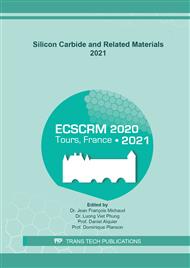p.346
p.351
p.356
p.361
p.366
p.371
p.376
p.383
p.389
Ray-Tracing Simulation Analysis of Effective Penetration Depths on Grazing Incidence Synchrotron X-Ray Topographic Images of Basal Plane Dislocations in 4H-SiC Wafers
Abstract:
Understanding the depth from which contrast from dislocations is still discernible (the effective penetration depth of the X-rays) in grazing-incidence synchrotron monochromatic beam X-ray topography is of great interest as it enables three-dimensional dislocation configuration analysis and accurate density calculations. To this end, systematic analysis has been performed of topographic and ray-tracing simulated contrast of basal plane dislocations with different Burgers vector and line direction combinations, and a universal method to determine the effective penetration depth based on ray tracing has been developed. This study reveals that the observable dislocation contrast depends on the effective misorientation associated with the dislocation modulated by the photoelectric absorption effect. The dislocations with larger effective misorientation tend to have longer projected length and correspondingly deeper effective penetration depths.
Info:
Periodical:
Pages:
366-370
Citation:
Online since:
May 2022
Keywords:
Permissions:
Share:
Citation:


